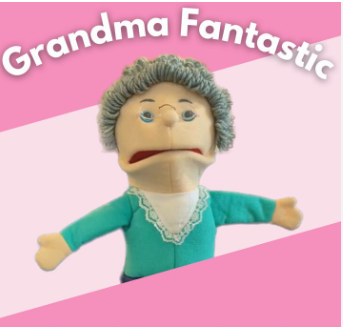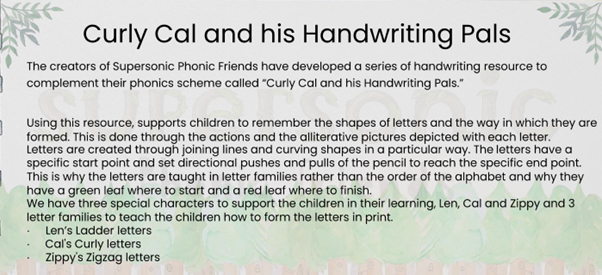Writing
Writing at JTR

At John T Rice Infant School we believe that the learning of writing skills should be embedded across the curriculum. The key skills of planning, composing and evaluating, spelling, handwriting & presentation, and grammar, punctuation and vocabulary are therefore taught explicitly in the context of English lessons, but also indirectly through cross-curricular writing tasks.
Writing in EYFS
In EYFS, writing is about how children build an understanding of the relationship between the spoken word and the written word, and how, through making marks, drawing and personal writing, children ascribe meaning to marks and attempt to write for various purposes. In EYFS there is a focus on prewriting skills and developing children’s gross and fine motor skills, which will support them in being ‘ready to write’. Key activities include Squiggle While you Wiggle, Dough Disco, Yoga, large-scale mark making, funky fingers activities and wake and shake. Children also have access to a wide range of outdoor equipment which they access throughout the day to support their gross motor development.
Children are encouraged and supported to mark make throughout their time in EYFS and a wide range of writing/mark-making materials are always available for children in their child-initiated learning and play both inside and outside.
In F2, children are introduced to drawing. Drawing Club incorporates story sharing, speaking and listening, drawing, writing, vocabulary, mathematics, imagination and collaboration. Each week we have a focus story or animation. The children learn new vocabulary linked to the story or animation and are invited to the Drawing Club, where they may draw a character, setting or event. They can innovate their drawings and add secret passwords, magic powers or spells, hidden symbols, letters or numerals. At the start of F2, the sessions may be purely drawings-based, but this will progress throughout the year to labelling their drawings with initial sounds, CVC words and eventually writing sentences about their drawings. The children love coming to Drawing Club!

Writing in KS1
The development of writing skills at KS1 progresses by building on the basic skills learnt at EYFS. Children are introduced to many different genres and opportunities are given for extended writing. Planning is based on ‘The Write Stuff’ approach. This approach makes sure that all of our children are exposed to high-quality texts that stimulate quality responses to reading, high-quality writing and purposeful speaking and listening opportunities. Our curriculum ensures that all children have plenty of opportunities to write for different purposes. We encourage writing through all curriculum areas and use quality reading texts to model examples of good writing. Writing is taught through a number of different strategies. High-quality texts plus ‘Hooks/Wows’ are used to excite and motivate children to write and also to give a purpose to their writing.
An individual lesson is based on a sentence model, broken into three chunks. With modelling at the heart of them, the sentence-stacking lessons are broken into bite-sized chunks and taught under the structural framework of The Writing Rainbow. Teachers prepare children for writing by modelling the ideas, grammar or techniques of writing.
● Initiate section – a stimulus to capture the children’s imagination and set up a sentence.
● Model section – the teacher close models a sentence that outlines clear writing features and techniques.
● Enable section – the children write their sentences, following the model.
There is also a big focus on vocabulary and Grandma Fantastic helps us to gather a wide range of interesting and aspirational vocabulary to use in our writing.


Spelling and Grammar
Spelling and Grammar is identified on teaching sequences and taught as part of our English and Phonics sessions. Through the SSPF’s scheme, children are taught spelling rules in year 1 and year 2, linked to the National Curriculum objectives. Common Exception words are taught daily, linked to our Supersonic Phonics Scheme.

Handwriting
We believe that a flexible, fluent and legible handwriting style empowers children to write with speed, confidence and creativity.
Handwriting is a developmental process with its own distinctive stages of sequential growth. There are five main stages:
Scheme
At JTR, we follow the Supersonic Phonics Friends validated phonics scheme, which also provides a series of handwriting resources which compliment the scheme called ‘Curly Cal and his handwriting Pals’.

Early Years Foundation Stage
Learners in the EYFS have planned opportunities to develop fine motor skills and mark make in a wide range of mediums within engaging and motivational contexts. In F2, handwriting will be taught as part of daily morning job sessions, daily phonics sessions, weekly handwriting carousel and weekly mark-making mornings. Great emphasis will be placed on teaching the correct posture, position and grip from the beginning and this should be carefully monitored and corrected where necessary.
EYFS Aims
- To use the correct pencil grip.
- To produce a controlled line which will support letter formation.
- To write letters using the correct sequence of movements.
- To understand how letters are formed and used to spell words.
- To write their own name.
- To form numbers correctly.
Pre-Handwriting skills
- Each FS class and the outdoor learning environment has a ‘Funky Fingers’ area where children are provided with activities to help to improve their finger strength and fine motor skills.
- FS1 children take part in daily ‘Squiggle While you Wiggle' sessions to improve gross and fine motor skills and to encourage the children to begin to make large and small-scale movements linked to handwriting patterns.
- FS2 children take part in daily ‘Dough Disco’ sessions to help to improve finger strength and fine motor control.
- FS children are given the opportunity to mark make within a range of media both inside and outside.
- Each FS class and the outdoor learning environment has a designated mark-making area where children are provided with a range of media with which to make mark.
- Mark-making opportunities are available throughout both the indoor and outdoor continuous provision.
- Children have access to a range of large-scale outdoor equipment to support the development of pre-handwriting skills and to help children to develop their core strength.
Handwriting
In the FS, children will be taught to:
- Air-write before writing on a larger scale, slowly encouraging letters to decrease in size and sit on the line.
- Use name cards to enable them to see what their name looks like and how the letters of their name are shaped/formed. In F2, they will practise their name writing each morning on white boards.
- Hold their pencil correctly and how to have the correct writing posture.
- Form numbers correctly, starting at the top.
- Form lower case letters with the correct orientation, starting in the correct place and finishing with a lead out, following the SSPFs scheme. Skills are taught, then consolidated and practised through a variety of other learning opportunities throughout the week.
Key Stage One
Handwriting will be taught explicitly in short regular sessions throughout the week following the SSPF’s scheme. Handwriting will also be taught through phonics sessions and other writing activities during the week. When children are consistently forming all upper and lower case letters correctly (ascenders and descenders), they will then be taught to join using the Teach Handwriting scheme.
During Year 1, children will be taught to:
- Understand which letters belong to which handwriting ‘families’ linked to the SSPF’s scheme (i.e. letters that are formed in similar ways) and to practise these.

- Sit correctly at a table, holding a pencil comfortably and correctly
- Form lower-case letters in the correct direction, starting and finishing in the right place
- Form capital letters correctly
- Form digits 0 – 9
During Year 2, children will be taught to:
- Form lower-case letters of the correct size relative to one another.
- Start using some of the diagonal and horizontal strokes needed to join letters and understand which letters, when adjacent to one another, are best left un-joined.
- Write capital letters and digits of the correct size, orientation and relationship to one another and to lower case letters.
- Use spacing between words that reflect the size of the letters.
Left-handers
Left-handers should have no greater difficulty in learning to write well than right-handers. They will automatically move the paper slightly to have a more comfortable angle so that their writing is visible. They should be reminded to start on the left of the page. Left-handers will be consistently reminded about the correct pencil grip and will be encouraged to hold the pencil higher to maximise the visibility of their writing.
